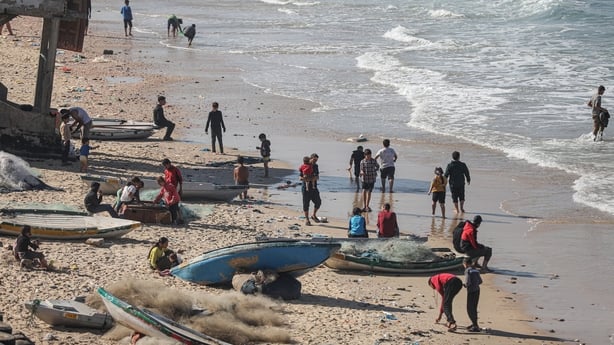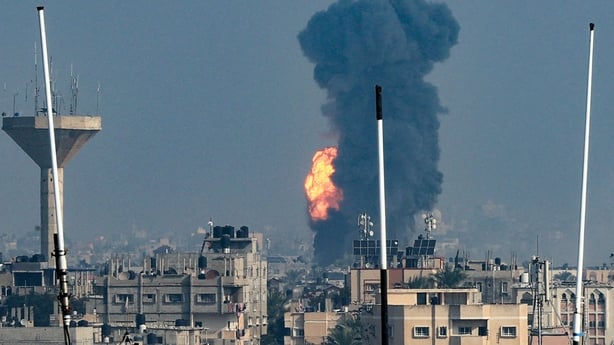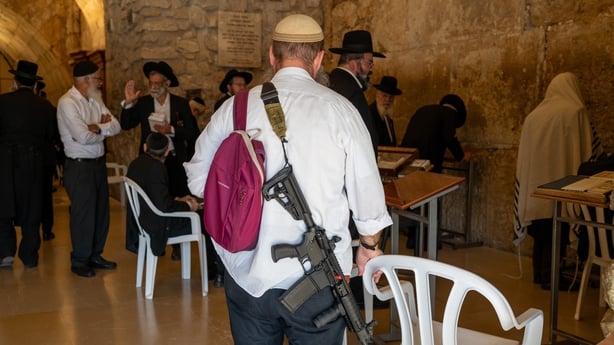In Israel everyone is consumed by the war in Gaza. As my RTÉ colleague and I prepare to board our flight out of Ben Gurion Airport, the flight attendant snaps: "There is just one side to this story, you must tell it".
"There are two sides to every story," I say, "we tell both".
She turns back determined, "just one side, you must tell it", welcome aboard! The one side stance is a refrain which we've heard from the earliest days of the war.
There are of course two sides to every story. It's an idiom which most journalists apply to everything we do. The ancient concept is linked to Pythagoras.
It is said it was first committed to print in the second US President’s diary and autobiography in the late 1700s.
No one knew better than John Adams that there are two sides to every story, he was one of the men who led the American Revolution, which secured independence from the British.
Tale of two sides
The conflict in Gaza is a tale of two sides on so many levels. The curt order issued by the flight attendant sparks in my memory during a morning walk along the sea front in Tel Aviv on a Wednesday morning in early November, just days after the Israeli ground invasion in Gaza got under way.
The clean golden beaches in Tel Aviv were quieter than normal. Sun bronzed paddle boarders gliding along; swimmers bathing in the warm November waters; a couple sit and hold each other close as they sip iced coffee.
The sands that line the Mediterranean in Israel painted a perfect seaside picture. In the distance a constant thud, thud, thud. The sound of war.
But it wasn't the sound of the aerial onslaught on Gaza. Approaching from the north was a small black dot low down on the skyline. As it got closer the ugly noise of war gets louder and louder. Eventually as it flies directly overhead, the huge helicopter laden with missiles and artillery cast a glancing shadow on the beach as it hurtled towards Gaza. The sound is deafening.
Minutes after it crosses the beach front, it will begin to fire down on Gaza and the 2.2 million citizens who live there. The beaches further south look different, Israeli tanks have taken up position, firing into the enclave from the shore.

As you move towards the southern tip of these most disputed of lands, the contrast on the seafront could not be more stark.
But for a brief few days during the ceasefire, the beaches in Gaza were flooded with families. Parents sat watching their children play, many of them with tears in their eyes, "we are on the beach, but we are sad," one mother says on a report broadcast on RTÉ's Six One news.
Paddle boarders and coffee sipping lovers on one beach, mothers crying on another. Two sides of the story.
This war is divisive. In the weeks we’ve spent in Israel I have lost count of the number of times people asked, "You support Israel?". It’s constant. Neutrality is viewed as being pro-Palestine, or anti-Israel.
A warm and inviting coffee shop owner can go from pleasant to stony in a simple exchange which asks, "where are you from?". More than once the conversation went no further than my response, "Ireland".
On Saturday, at 3.54am, I wake to the sound of a message on my phone. "Heavy attacks and bombardment at the moment, in Khan Younis", it reads.

The war is back, the days of peace over, days in which the world got to see properly for the first time the real scale of the devastation inside Gaza because of the war.
During the truce many of those I've been in contact with on a daily basis fell silent, resting now after weeks of the torture of living under daily bombardment.
The text is a reminder that the horror has returned. It comes with a video lasting one minute and 12 seconds. Mostly blackness, dogs barking, the sounds of large booms and shots being fired in the distance. It is punctuated by large orange flashes, as massive bombs light up the Gaza skyline.
I reply, "stay as safe as you can". A short time later another video arrives, this time the skyline is bright with the sun blaring down on Gaza, a short distance away there is a huge plume of black smoke, the aftermath of an airstrike.
Then the all too familiar whooshing sound that comes seconds before another strike. "Oh my God, oh my God", the person recording the video says over and over again. "It’s near us, where to go now?"
This is the other side of the story, the side that tells about families moving further and further away from their homes in Gaza. The airstrikes that displace them. The bombs that kill them.
In the second video, which was sent to my phone, you can see people run in all directions, panicked. Many of them are afraid that it is not a question of if, but when they or their families will be killed.
Then a voice message arrives. "We are fed up, this war, this genocide, this massacre must stop, enough killing, this must stop". Despite all the leaflets being dropped by the Israeli Defense Forces, or zones published of where will be bombed, these people have no idea where to go to be safe.
Fear of death
That fear of death is not one confined to Gaza. All over Israel, people carrying large automatic weapons are commonplace.

Young fathers drinking takeaway coffee and pushing their babies in prams wear them. Friends meeting for lunch, men and women, carry them. In restaurants you can sometimes notice the handle of a handgun protruding from the top of a waiter's trousers. The fear of infiltration is real.
Last Thursday morning, the ceasefire was still in place when the Palestinian Nemer brothers, two Hamas members, opened fire on a bus stop in east Jerusalem. They killed three innocent people; that fear of infiltration exists for a reason.
The Israeli army killed a fourth, an Israeli civilian, by mistake. Yuval Doron Castleman had been shooting at the Hamas members. He like many people in Israel was carrying a gun. Infiltrations like these play on the mind of people living in Israel.
The Nemers were shot dead by the IDF too.
When your neighbour is Hamas, and it disputes your right to exist, you can understand why people in Israel are on guard.
The hills of the Holy Land have been stained with blood for hundreds of years. Israel-Palestine is one of the deepest, most divisive and bitter conflicts of our generation, and several generations before, and the sad reality is, the same might be said for several generations to come.
Most scholars of this conflict now concede a two-state solution is unlikely. An effort to push Palestinians south into the Sinai Peninsula is, many expect, under way.
We should have learned that more violence and bloodshed won't bring about a solution. If it did, the blood already spilt this year, and in all the other intifadas and assaults would have done so.
It's time to talk and listen and learn from the mistakes of others. The US has started to speak more about protecting the civilian population inside Gaza.
If there is to be a sustainable, lasting solution, perhaps looking to our own island would be a good place to start. For a Middle East that is teetering on the brink of another humanitarian catastrophe, and thousands of more deaths, a solution is badly needed.






